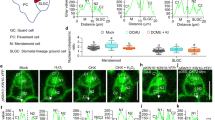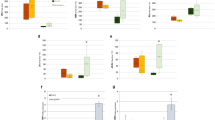Abstract
Stomata in the epidermal tissues of leaves are valves through which passes CO2, and as such they influence the global carbon cycle1. The two-dimensional pattern and density of stomata in the leaf epidermis are genetically and environmentally regulated to optimize gas exchange2. Two putative intercellular signalling factors, EPF1 and EPF2, function as negative regulators of stomatal development in Arabidopsis, possibly by interacting with the receptor-like protein TMM3,4,5,6. One or more positive intercellular signalling factors are assumed to be involved in stomatal development, but their identities are unknown7. Here we show that a novel secretory peptide, which we designate as stomagen, is a positive intercellular signalling factor that is conserved among vascular plants. Stomagen is a 45-amino--rich peptide that is generated from a 102-amino-acid precursor protein designated as STOMAGEN. Both an in planta analysis and a semi-in-vitro analysis with recombinant and chemically synthesized stomagen peptides showed that stomagen has stomata-inducing activity in a dose-dependent manner. A genetic analysis showed that TMM is epistatic to STOMAGEN (At4g12970), suggesting that stomatal development is finely regulated by competitive binding of positive and negative regulators to the same receptor. Notably, STOMAGEN is expressed in inner tissues (the mesophyll) of immature leaves but not in the epidermal tissues where stomata develop. This study provides evidence of a mesophyll-derived positive regulator of stomatal density. Our findings provide a conceptual advancement in understanding stomatal development: inner photosynthetic tissues optimize their function by regulating stomatal density in the epidermis for efficient uptake of CO2.
This is a preview of subscription content, access via your institution
Access options
Subscribe to this journal
Receive 51 print issues and online access
$199.00 per year
only $3.90 per issue
Buy this article
- Purchase on Springer Link
- Instant access to full article PDF
Prices may be subject to local taxes which are calculated during checkout




Similar content being viewed by others
References
Hetherington, A. M. & Woodward, F. I. The role of stomata in sensing and driving environmental change. Nature 424, 901–908 (2003)
Nadeau, J. A. & Sack, F. D. Stomatal development in Arabidopsis . In The Arabidopsis Book (eds Someville, C. & Meyerowitz, E) 10.1199/tab.0066 (American Society of Plant Biologists, 2002)
Nadeau, J. A. & Sack, F. D. Control of stomatal distribution on the Arabidopsis leaf surface. Science 296, 1697–1700 (2002)
Hara, K., Kajita, R., Torii, K. U., Bergmann, D. C. & Kakimoto, T. The secretory peptide gene EPF1 enforces the stomatal one-cell-spacing rules. Genes Dev. 21, 1720–1725 (2007)
Hunt, L. & Gray, J. E. The signaling peptide EPF2 controls asymmetric cell divisions during stomatal development. Curr. Biol. 19, 864–869 (2009)
Hara, K. et al. Epidermal cell density is autoregulated via a secretory peptide, EPIDERMAL PATTERNING FACTOR 2 in Arabidopsis leaves. Plant Cell Physiol. 50, 1019–1031 (2009)
Bergmann, D. C. Integrating signals in stomatal development. Curr. Opin. Plant Biol. 7, 26–32 (2004)
Shpak, E. D., McAbee, J. M., Pillitteri, L. J. & Torii, K. U. Stomatal patterning and differentiation by synergistic interactions of receptor kinases. Science 309, 290–293 (2005)
Berger, D. & Altmann, T. A subtilisin-like serine protease involved in the regulation of stomatal density and distribution in Arabidopsis thaliana . Genes Dev. 14, 1119–1131 (2000)
Nadeau, J. A. Stomatal development: new signals and fate determinants. Curr. Opin. Plant Biol. 12, 29–35 (2009)
Obayashi, T., Hayashi, S., Saeki, M., Ohta, H. & Kinoshita, K. ATTED-II provides coexpressed gene networks for Arabidopsis . Nucleic Acids Res. 37, D987–D991 (2009)
Sachs, T. The development of spacing patterns in the leaf epidermis. In Clonal Basis of Development 161–182 (Academic Press, 1987)
MacAlister, C. A., Ohashi-Ito, K. & Bergmann, D. C. Transcription factor control of asymmetric cell divisions that establish the stomatal lineage. Nature 445, 537–540 (2007)
Pillitteri, L. J., Sloan, D. B., Bogenschutz, N. L. & Torii, K. U. Termination of asymmetric cell division and differentiation of stomata. Nature 445, 501–505 (2007)
Serna, L., Torres-Contreras, J. & Fenoll, C. Specification of stomatal fate in Arabidopsis: evidences for cellular interactions. New Phytol. 153, 399–404 (2002)
Geisler, M., Yang, M. & Sack, F. D. Divergent regulation of stomatal initiation and patterning in organ and suborgan regions of the Arabidopsis mutants too many mouths and four lips . Planta 205, 522–530 (1998)
Geisler, M., Nadeau, J. & Sack, F. D. Oriented asymmetric divisions that generate the stomatal spacing pattern in Arabidopsis are disrupted by the too many mouths mutation. Plant Cell 12, 2075–2086 (2000)
von Grolla, U., Bergera, D. & Altmann, T. The subtilisin-like serine protease SDD1 mediates cell-to-cell signaling during Arabidopsis stomatal development. Plant Cell. 14, 1527–1539 (2002)
Schwab, R., Ossowski, S., Riester, M., Warthmann, N. & Weigel, D. Highly specific gene silencing by artificial microRNAs in Arabidopsis . Plant Cell 18, 1121–1133 (2006)
Dohi, K., Tamai, A. & Mori, M. Insertion in the coding region of the movement protein improves stability of the plasmid encoding a tomato mosaic virus-based expression vector. Arch. Virol. 153, 1667–1675 (2008)
Kono, A. et al. The Arabidopsis D-type cyclin CYCD4 controls cell division in the stomatal lineage of the hypocotyl epidermis. Plant Cell 19, 1265–1277 (2007)
Hara-Nishimura, I., Takeuchi, Y., Inoue, K. & Nishimura, M. Vesicle transport and processing of the precursor to 2S albumin in pumpkin. Plant J. 4, 793–800 (1993)
Shimada, T. et al. AtVPS29, a putative component of a retromer complex, is required for the efficient sorting of seed storage proteins. Plant Cell Physiol. 47, 1187–1194 (2006)
Kunieda, T. et al. NAC family proteins NARS1/NAC2 and NARS2/NAM in the outer integument regulate embryogenesis in Arabidopsis . Plant Cell 20, 2631–2642 (2008)
Livak, K. J. & Schmittgen, T. D. Analysis of relative gene expression data using real-time quantitative PCR and the 2-ΔΔC(T) method. Methods 25, 402–408 (2001)
Kinoshita, T. et al. Vacuolar processing enzyme is up-regulated in the lytic vacuoles of vegetative tissues during senescence and under various stressed conditions. Plant J. 19, 43–53 (1999)
Jensen, O. N., Podtelejnikov, A. & Mann, M. Delayed extraction improves specificity in database searches by matrix-assisted laser desorption/ionization peptide maps. Rapid Commun. Mass Spectrom. 10, 1371–1378 (1996)
Acknowledgements
We thank T. Nakagawa for donating the TMM::GFP seeds; K. Yamada for his technical support of quantitative PCR; and Y. Nakata for her technical support of in situ hybridization. We thank J. Raymond for reading and editing the manuscript. We thank the ABRC for providing seeds of Arabidopsis T-DNA insertion lines. This work was supported by Grants-in-Aid for Scientific Research (no. 16085203 and 17107002) from the Ministry of Education, Culture, Sports, Science and Technology (MEXT) of Japan, by the Global Center of Excellence Program ‘Formation of a Strategic Base for Biodiversity and Evolutionary Research: from Genome to Ecosystem’ of MEXT, and by Japan Science and Technology Agency (JST).
Author Contributions T.S. performed in silico screening to identify STOMAGEN. S.S.S. established the STOMAGEN-RNAi lines, performed genetic interaction experiments and other experiments including antibody production and in situ hybridization. S.S.S. also purified recombinant stomagen, refolded chemically synthesized stomagen, and evaluated their stomata inducing activities. Y.I. developed the STOMAGEN-OX and pSTOMAGEN::GUS lines. A.T. and M.M. produced stomagen in tobacco-cultured cells by using their ToMV-expression system. K.O. conducted MS analysis of STOMAGEN–Venus. I.H.-N. and T.S. designed this project and supervised. S.S.S., T.S. and I.H.-N. wrote the paper with input from co-authors.
Author information
Authors and Affiliations
Corresponding author
Ethics declarations
Competing interests
The authors declare no competing financial interests.
Supplementary information
Supplementary Information
This file contains Supplementary Figures 1-10 with Legends and Supplementary Tables 1-2. (PDF 4673 kb)
Rights and permissions
About this article
Cite this article
Sugano, S., Shimada, T., Imai, Y. et al. Stomagen positively regulates stomatal density in Arabidopsis. Nature 463, 241–244 (2010). https://doi.org/10.1038/nature08682
Received:
Accepted:
Published:
Issue Date:
DOI: https://doi.org/10.1038/nature08682
This article is cited by
-
Small secreted peptides (SSPs) in tomato and their potential roles in drought stress response
Molecular Horticulture (2023)
-
Optimization of rice panicle architecture by specifically suppressing ligand–receptor pairs
Nature Communications (2023)
-
Mobile Signaling Peptides: Secret Molecular Messengers with a Mighty Role in Plant Life
Journal of Plant Growth Regulation (2023)
-
Drought stress inhibits stomatal development to improve water use efficiency in cotton
Acta Physiologiae Plantarum (2023)
-
Leucine-Rich Repeat Receptor-Like Proteins in Plants: Structure, Function, and Signaling
Journal of Plant Biology (2023)
Comments
By submitting a comment you agree to abide by our Terms and Community Guidelines. If you find something abusive or that does not comply with our terms or guidelines please flag it as inappropriate.



